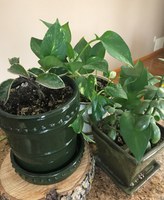Dakota Gardener: Winter Houseplant Care
(Click an image below to view a high-resolution image that can be downloaded)
By Carrie Knutson, NDSU Extension Agent, Grand Forks County
Houseplants were one of the many trends during this past year.
Even if your outings were limited, you may have snuck one or two houseplants home with your groceries or made a stop at the local garden center to see what you could add to your collection, just speaking from my experience.
How do you care for your indoor plants to ensure they don’t get relocated to the compost pile this winter?
Four of the hardest things for houseplants to face during the winter are a lack of light, low humidity, cold drafts and drying heat.
Let’s start with light. Make sure your plants are getting the correct amount of sunlight as the days grow shorter and the position of the sun changes. If the new growth on your plants is thin and spindly, you might have to move plants to take advantage of the brighter light from south-facing windows.
Our homes can have low relative humidity of 10% to 20% during the winter. In general, houseplants prefer a relative humidity of 40% to 50%.
One way to increase the relative humidity around houseplants is to group the plants together in a room. Another way is to place plants on a tray with pebbles and add water. Make sure the bottom of the pot is above water level.
You also can place plants that need more humidity in a bathroom or kitchen, provided the room has enough light. You also can buy small humidifiers and place them near the houseplants.
Houseplants favor temperatures between 65 and 75 ̊F, which are achievable for us in the winter. However, fast changes in temperatures can hurt plants, which may result in leaf drop and stressed plants.
Keep your houseplants away from cold drafts from outside doors. If you have plants on your windowsill, be mindful of the changes in temperature as our weather gets colder. Don’t let leaves touch cold windows.
Move houseplants away from the drying warmth of heat sources.
Remember to water houseplants thoroughly. Place the pot in a sink and water until water runs out the bottom of the pot. Then water one more time. This ensures the potting soil is thoroughly moist.
If your houseplants are too large to move to a sink, you can use a tray or other container that is large enough to fit the pot and catch the excess water.
Houseplants do not need fertilizer during the winter because the reduced light and temperatures result in slower growth. The ideal time to fertilize is during the spring and summer.
Happy gardening!
For more information about gardening, contact your local NDSU Extension agent. Find the Extension office for your county at https://www.ag.ndsu.edu/extension/directory/counties.
NDSU Agriculture Communication - Dec. 29, 2020
Source: Carrie Knutson, 701-780-8229, carrie.knutson@ndsu.edu
Editor: Ellen Crawford, 701-231-5391, ellen.crawford@ndsu.edu




